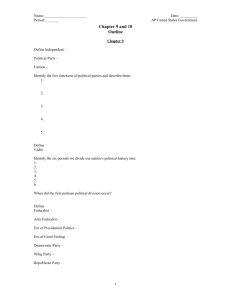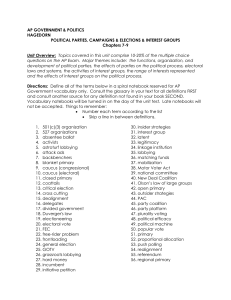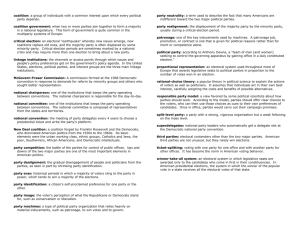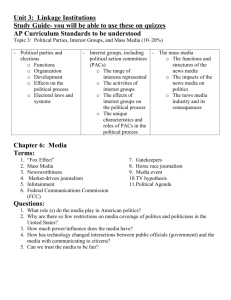A More Empirical Approach State-by
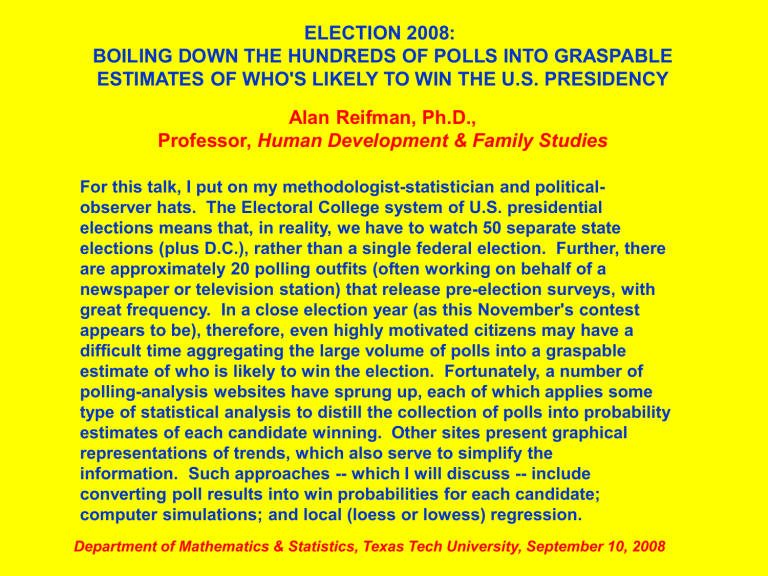
ELECTION 2008:
BOILING DOWN THE HUNDREDS OF POLLS INTO GRASPABLE
ESTIMATES OF WHO'S LIKELY TO WIN THE U.S. PRESIDENCY
Alan Reifman, Ph.D.,
Professor, Human Development & Family Studies
For this talk, I put on my methodologist-statistician and politicalobserver hats. The Electoral College system of U.S. presidential elections means that, in reality, we have to watch 50 separate state elections (plus D.C.), rather than a single federal election. Further, there are approximately 20 polling outfits (often working on behalf of a newspaper or television station) that release pre-election surveys, with great frequency. In a close election year (as this November's contest appears to be), therefore, even highly motivated citizens may have a difficult time aggregating the large volume of polls into a graspable estimate of who is likely to win the election. Fortunately, a number of polling-analysis websites have sprung up, each of which applies some type of statistical analysis to distill the collection of polls into probability estimates of each candidate winning. Other sites present graphical representations of trends, which also serve to simplify the information. Such approaches -- which I will discuss -- include converting poll results into win probabilities for each candidate; computer simulations; and local (loess or lowess) regression.
Department of Mathematics & Statistics, Texas Tech University, September 10, 2008
The Electoral College System
• Each state’s EV’s = No. of U.S. House seats (based on pop’n) + 2 U.S. Senate Seats
• All states (except NE & ME) winner-takeall; even if candidate narrowly wins state’s popular vote, he or she still gets 100% of state’s EV’s
•
Need 270 Electoral Votes to win the presidency
Many states are overwhelmingly D or R leaning and thus not contested (see dark blue and red below), but the remaining states are competitive to varying degrees http://en.wikipedia.org/wiki/Image:US_Electoral_College_Map.PNG
http://www.electoral-vote.com/
In Each of the “Swing” States, Many Polls Are Taken,
Requiring Some Type of WithinState Aggregation (“Meta-Analysis”)
• Simple Averaging (Arithmetic Mean): http://www.realclearpolitics.com/
• Weighted Average: http://www.fivethirtyeight.com/
Typical Poll
Report Format
Smith…….53%
Jones……47%
Margin of Error
+/- 3%
(which includes possibility the race is really 50/50)
True value of parameter will be within point estimate +/- MoE, with 95% confidence
53
50 56
Extra 2.5% on this side would also indicate winning; hence Smith would have…
97.5% probability of winning, hardly a
“statistical dead-heat”
Based on Ayres, Super Crunchers, pp. 202-204
Normal curve from: http://www.gseis.ucla.edu/courses/ed230a2/notes/z1.html
Which is consistent with…
http://www.washingtonmonthly.com/archives/individual/2004_08/004536.php
A More Empirical Approach
http://politicalarithmetik.blogspot.com/2006/11/from-poll-margin-to-wins-polls-as.html
State-by-State Candidate Win Percentages Can Then Be Used to Conduct Simulations of the Overall Election
As a simplified example, suppose our best estimate is that Obama has a
60% probability of winning a given state and McCain has a 40% probability…
1
HAVE COMPUTER
GENERATE A
RANDOM
NUMBER
BETWEEN
1-100
ONE “ELECTION”
CONSISTS OF A
SIMULATION FOR
EVERY STATE;
THOUSANDS OF
ELECTIONS CAN
BE SIMULATED
60
61
100
OBAMA
“WINS”
McCAIN
“WINS”
http://www.fivethirtyeight.com/ 10,000 simulations per day http://hominidviews.com/ 100,000 simulations per day
Thanks to Peter Westfall for bringing this to my attention
LO cally E stimated S catterplot S moothing (LOESS) Regression
*
*Also LOWESS, with W for Weighted
“
”
http://www.pollster.com/faq/map_faq.php
http://www.fivethirtyeight.com/2008/06/we-know-more-than-we-think-big-change-2.html
http://en.wikipedia.org/wiki/Local_regression
http://n-steps.tetratech-ffx.com/PDF&otherFiles/stat_anal_tools/LOESS_final.pdf
Other Useful Websites http://election.princeton.edu/ http://election-projection.net/
(not to be confused with http://www.electionprojection.com
)
Scroll down to “Probability of Win by State,” then click on color bars
Also see: http://election-projection.net/mathematics.html
http://stochasticdemocracy.blogspot.com/

